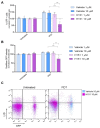Impact of Genomic Mutation on Melanoma Immune Microenvironment and IFN-1 Pathway-Driven Therapeutic Responses
- PMID: 39061208
- PMCID: PMC11274745
- DOI: 10.3390/cancers16142568
Impact of Genomic Mutation on Melanoma Immune Microenvironment and IFN-1 Pathway-Driven Therapeutic Responses
Abstract
The BRAFV600E mutation, found in approximately 50% of melanoma cases, plays a crucial role in the activation of the MAPK/ERK signaling pathway, which promotes tumor cell proliferation. This study aimed to evaluate its impact on the melanoma immune microenvironment and therapeutic responses, particularly focusing on immunogenic cell death (ICD), a pivotal cytotoxic process triggering anti-tumor immune responses. Through comprehensive in silico analysis of the Cancer Genome Atlas data, we explored the association between the BRAFV600E mutation, immune subtype dynamics, and tumor mutation burden (TMB). Our findings revealed that the mutation correlated with a lower TMB, indicating a reduced generation of immunogenic neoantigens. Investigation into immune subtypes reveals an exacerbation of immunosuppression mechanisms in BRAFV600E-mutated tumors. To assess the response to ICD inducers, including doxorubicin and Me-ALA-based photodynamic therapy (PDT), compared to the non-ICD inducer cisplatin, we used distinct melanoma cell lines with wild-type BRAF (SK-MEL-2) and BRAFV600E mutation (SK-MEL-28, A375). We demonstrated a differential response to PDT between the WT and BRAFV600E cell lines. Further transcriptomic analysis revealed upregulation of IFNAR1, IFNAR2, and CXCL10 genes associated with the BRAFV600E mutation, suggesting their involvement in ICD. Using a gene reporter assay, we showed that PDT robustly activated the IFN-1 pathway through cGAS-STING signaling. Collectively, our results underscore the complex interplay between the BRAFV600E mutation and immune responses, suggesting a putative correlation between tumors carrying the mutation and their responsiveness to therapies inducing the IFN-1 pathway, such as the ICD inducer PDT, possibly mediated by the elevated expression of IFNAR1/2 receptors.
Keywords: BRAFV600E; IFN-1 pathway; cGAS-STING; immunogenic cell death.
Conflict of interest statement
The authors declare no conflicts of interest. The funders had no role in the design of the study; in the collection, analyses, or interpretation of data; in the writing of the manuscript, or in the decision to publish the results.
Figures




Similar articles
-
Photodynamic Modulation of Type 1 Interferon Pathway on Melanoma Cells Promotes Dendritic Cell Activation.Front Immunol. 2019 Nov 8;10:2614. doi: 10.3389/fimmu.2019.02614. eCollection 2019. Front Immunol. 2019. PMID: 31781113 Free PMC article.
-
17-AAG inhibits vemurafenib-associated MAP kinase activation and is synergistic with cellular immunotherapy in a murine melanoma model.PLoS One. 2018 Feb 26;13(2):e0191264. doi: 10.1371/journal.pone.0191264. eCollection 2018. PLoS One. 2018. PMID: 29481571 Free PMC article.
-
Combined p14ARF and Interferon-β Gene Transfer to the Human Melanoma Cell Line SK-MEL-147 Promotes Oncolysis and Immune Activation.Front Immunol. 2020 Oct 22;11:576658. doi: 10.3389/fimmu.2020.576658. eCollection 2020. Front Immunol. 2020. PMID: 33193370 Free PMC article.
-
[Progress of anti-tumor study based on BRAF].Yao Xue Xue Bao. 2012 Dec;47(12):1567-74. Yao Xue Xue Bao. 2012. PMID: 23460959 Review. Chinese.
-
BRAF V600-Mutated Metastatic Melanoma and Targeted Therapy Resistance: An Update of the Current Knowledge.Cancers (Basel). 2023 May 4;15(9):2607. doi: 10.3390/cancers15092607. Cancers (Basel). 2023. PMID: 37174072 Free PMC article. Review.
Cited by
-
Interplay between cancer-associated fibroblasts and dendritic cells: implications for tumor immunity.Front Immunol. 2025 May 16;16:1515390. doi: 10.3389/fimmu.2025.1515390. eCollection 2025. Front Immunol. 2025. PMID: 40453074 Free PMC article. Review.
-
RIPK4 Downregulation Reduces ABCG2 Expression, Increasing BRAF-Mutated Melanoma Cell Susceptibility to Cisplatin- and Doxorubicin-Induced Apoptosis.Biomolecules. 2024 Dec 10;14(12):1573. doi: 10.3390/biom14121573. Biomolecules. 2024. PMID: 39766280 Free PMC article.
References
Grants and funding
LinkOut - more resources
Full Text Sources
Research Materials
Miscellaneous

